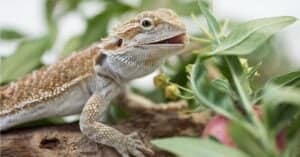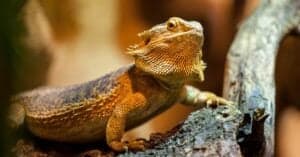Bearded dragons were first introduced as pets into the United States in the 1990s, but have quickly become one of America’s favorite pet lizards. These gentle creatures possess reptilian scales and a beard of spikes that puffs up as their mood changes.
Bearded dragons are well known to be naturally gentle, and you will find them active during the day. You’ll most likely find them around arid areas, scrublands, and deserts in their native habitats in Australia. So whether you’re considering getting a pet bearded dragon or just admiring these incredible lizards, you’ve probably wondered just how big they get. We’ll answer that question and more below!
How Big Do Bearded Dragons Get?

grow as big as 16-24 inches long and weigh about 0.62-1.1 pounds.
©Zhitkov Boris/Shutterstock.com
Bearded Dragons grow as big as 16-24 inches in length and weigh about 0.62-1.1 pounds. They usually attain their full size immediately after reaching sexual maturity, between 8-18 months after birth.
The largest type of bearded dragon isn’t a species, but rather bearded dragons that have been bred for size. They’re named German bearded dragons and they’re now extremely rare. The largest species of bearded dragon you’ll find in nature is the central bearded dragon, which reaches 24 inches in length.
Bearded dragons also suffer stunted growth at times. The minimum length for a typical bearded dragon after 12 months is 16 inches, and the weight is around 0.62 pounds. So if your bearded dragon is over 12 months and still below 16 inches or weighs anything less than 0.62 pounds, it may have stunted growth. This could be due to a variety of factors, such as insufficient lighting, bad feeding, diseases, or parasites.
The growth rate of baby bearded dragons is quite a fast one. In the first 3 months of their birth, they grow to around 3 to 11 inches long. So on average, they increase in length by about 4-6 inches every month.
Once they become juveniles, which is around 3 months after their birth, their growth rate usually slows down. They only increase in length by about 1-1.5 inches monthly.
It is difficult to predict the eventual size of your bearded dragon as it is dependent on the environment, health, and diet of the animal.
What is the Size of a Baby Bearded Dragon?

A hatchling may weigh up to 11 inches long.
©iStock.com/JeannetteKatzir
Baby bearded dragons, also known as hatchlings, can reach up to 9-11 inches in length after 2 months of birth. As earlier said, at this stage, they experience very rapid growth and development. They usually increase in length weekly by about 1-1.5 inches. They also increase in weight by about 0.011-0.077 pounds monthly.
At this stage, frequent feeding is required to sustain them. It is also important to weigh them from time to time to ensure that they are still maintaining the expected growth rate. If you observe at any point in time that they aren’t growing at expected rates, it is advised to look into their food – perhaps they aren’t getting enough. Lighting should also be checked – in order to best copy the ultraviolet light bearded dragons receive in the wild, high ultraviolet output light bulbs must be used indoors.
They should be fed more insects than vegetables because they require more protein in their diet to aid in their growth. Since bearded dragons find it difficult to eat when they have metabolic bone disease, they should be examined if they’re not eating properly.
What is the Size of a Juvenile Bearded Dragon?
A bearded dragon is considered a juvenile at 2-7 months old. During this stage, they have a reduced growth rate compared to the first 2 months. The growth rate usually recorded for juveniles per month is about 1-1.5 inches.
Juveniles need excellent and high-quality nutrition at this stage of their growth. Also during this stage, proper monitoring is required, especially concerning their nutrition. If multiple juvenile bearded dragons are kept together after hatching, larger ones may overwhelm smaller dragons and eat their food, leaving them nutritionally deficient.
What is the Size of an Adult Bearded Dragon?
Adult bearded dragons are usually around 16-22 inches long(24 inches at most), with a weight that ranges from 10-18 ounces. Bearded dragons typically reach adulthood once they attain sexual maturity. This usually happens between 8-18 months after birth.
Factors that Affect the Size of A Bearded Dragon

Incorrect UVB setup may affect the growth of a bearded dragon.
©Frank C. Müller, Baden-Baden, CC BY-SA 2.5, via Wikimedia Commons – License
There are a number of factors that could affect the growth rate of a bearded dragon, either positively or negatively. Let us consider some of them.
Genetics
Genetics is a great factor that influences the size of bearded dragons. The genes inherited from the bearded dragon’s parent will determine the animal’s size. For example, earlier we mentioned that the largest bearded dragons in the world are German bearded dragons. These bearded dragons aren’t a unique species, but rather was the creation of selective breeding that paired large bearded dragons together to create a larger “breed.”
Diet
Nutritious and proper diets are required for bearded dragons in all stages of their development. Baby bearded dragons should be fed with highly proteinous foods like insects to speed up their rapid growth process. Vegetables can then come in as they advance in age and size.
It is essential to know that if bearded dragons are not adequately fed, especially in their rapid growth stage, it could result in stunted growth and possibly other health problems. Older dragons should be given balanced diets at all times to reduce the occurrence of indigestion that is common to them.
UV Lighting
Lack of UV lighting from the sun or high ultraviolet output light bulbs in captivity affects the growth of bearded dragons negatively. The presence of UVB from the sun (for bearded dragons in the wild) or specialized UVB light (for those in captivity) may help to prevent stunted growth in them.
Gender
Gender goes a long way in determining the size of bearded dragons. Males are usually larger and thicker than females. The females’ bodies tend to be broader than the males, who have slimmer bodies and tails. So this should affect your choice between a male or female bearded dragon.
Housing
It is essential to make sure there is enough space in the place where you keep your bearded dragon. Limited space can also cause stunted growth in adult bearded dragons because they lack the needed room to grow and exercise their bodies.
So when constructing their enclosures, make sure to give your bearded enough room!
The photo featured at the top of this post is © iStock.com/huettenhoelscher
Thank you for reading! Have some feedback for us? Contact the AZ Animals editorial team.






